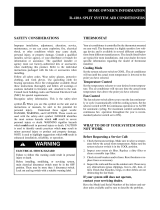
Safety Considerations
Improper installation adjustment, alteration, service, maintenance, or use
can cause explosion, fire, electrical shock, or other conditions which
may cause death, personal injury, or property damage. Consult a
qualified installer, service agency, or your distributor or branch for
information or assistance. The qualified installer or agency must use
factory-authorized kits or accessories when modifying this product Refer
to the individual instructions packaged with the kits or accessories when
installing.
Follow all safety codes. Wear safety glasses, protective clothing, and
work gloves. Use quenching cloth for brazing operations. Have a fire
extinguisher available. Read these instructions thoroughly and follow all
warnings or cautions included in literature and attached to the unit.
Consult local building codes, the current editions of the National
Electrical Code (NEC) NFPA 70.
In Canada refer to the current editions of the Canadian electrical Code
CSA C22.1.
Recognize safety information. This is the safety-alert symbol . When
you see this symbol on the unit and in instructions or manuals, be alert to
the potential for personal injury. Understand these signal words;
DANGER, WARNING, and CAUTION. These words are used with the
safety-alert symbol. DANGER identifies the most serious hazards which
will result in severe personal injury or death. WARNING signifies
hazards which could result in personal injury or death. CAUTION is
used to identify unsafe practices which may result in minor personal
injury or product and property damage. NOTE is used to highlight
suggestions which will result in enhanced installation, reliability, or
operation.
NOTE: Installer: This manual should be left with the equipment user.
Starting or Shutting Unit Off
To start the unit:
1. Turn on the electrical power supply to unit.
2. Select temperature and set MODE control to desired mode.
To shut unit off:
NOTE: If the unit is being shut down because of a malfunction, call
your dealer as soon as possible.
1. Set system MODE control to OFF.
2. Turn off the electrical power supply to unit.
Operating Your Unit
The operation of your unit is controlled by indoor thermostat. You
simply adjust the thermostat and it maintains the indoor temperature at
the level you select. Most thermostats of cooling systems have 3
controls: a temperature control selector, a FAN control, and a SYSTEM
or MODE control. Refer to your thermostat owner’s manual for more
information.
To better protect your investment and to eliminate unnecessary service
calls, familiarize yourself with the following facts:
Cooling Mode
With the SYSTEM or MODE control set to COOL, your unit will run in
cooling mode until the indoor temperature is lowered to the level you
have selected. On extremely hot days, your unit will run for longer
periods at a time and have shorter “off” periods than on moderate days.
Heating Mode (if installed with optional electric
heat)
Your system may also be equipped with an electric heating source. On
cold days and nights, place your MODE control to HEAT and your
system will automatically turn on the supplemental heat in order to
maintain the level of comfort you have selected.
Maintenance and Service
This section discusses maintenance that should be performed on your
system. Most maintenance should be performed by your dealer. You, as
the owner, may wish to handle some minor maintenance for your new
unit.
Routine Maintenance
All routine maintenance should be handled by skilled, experienced
personnel. Your dealer can help you establish a standard procedure.
WARNING
!
FIRE, EXPLOSION, ELECTRICAL SHOCK HAZARD
Failure to follow this warning could result in personal injury, death,
and/or property damage.
Installation and servicing of this equipment can be hazardous due to
mechanical and electrical components. Only trained and qualified
personnel should install, repair, or service this equipment.
WARNING
!
FIRE, EXPLOSION HAZARD
Failure to follow this warning could result in personal injury, death,
and/or property damage.
Do not store or use combustible materials, gasoline, or other flammable
vapors and liquids in the vicinity of this or any other appliance.
WARNING
!
ELECTRICAL SHOCK HAZARD
Failure to follow this warning could result in personal injury and/or
death.
Before performing recommended maintenance, be sure the main power
switch to unit is turned off and lock-out tag is installed.
CAUTION
!
CUT HAZARD
Failure to follow this caution may result in personal injury.
When removing access panels or performing maintenance functions
inside your unit, be aware of sharp sheet metal parts and screws.
Although special care is taken to reduce sharp edges to a minimum, be
extremely careful and wear appropriate clothing, safety glasses and
gloves when handling parts or reaching into the unit.
WARNING
!
FIRE, EXPLOSION, ELECTRICAL SHOCK HAZARD
Failure to follow this warning could result in personal injury, death or
property damage.
Do not use this unit if any part has been under water. Immediately call a
qualified service technician to inspect the unit and to replace any part of
the control system which has been under water.






